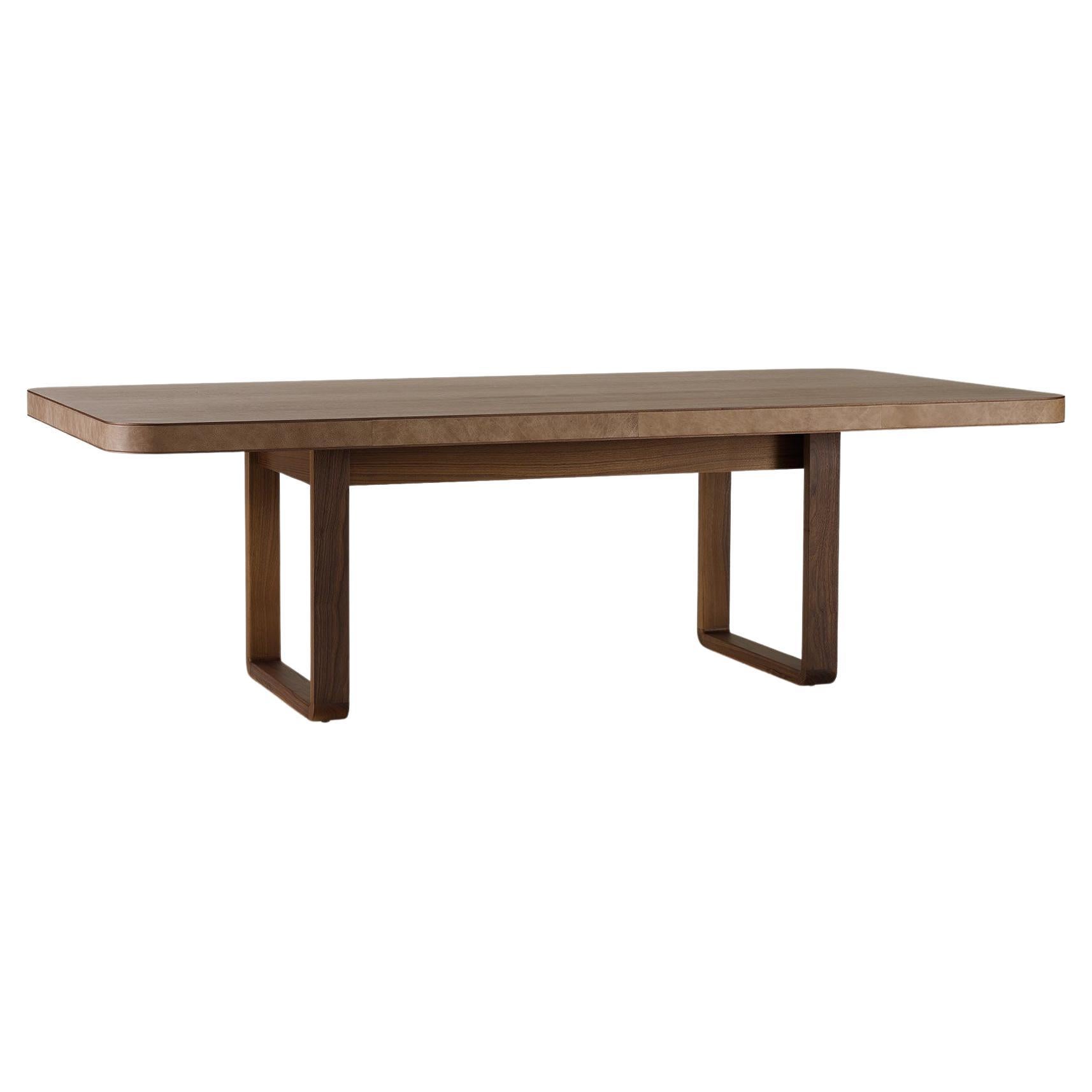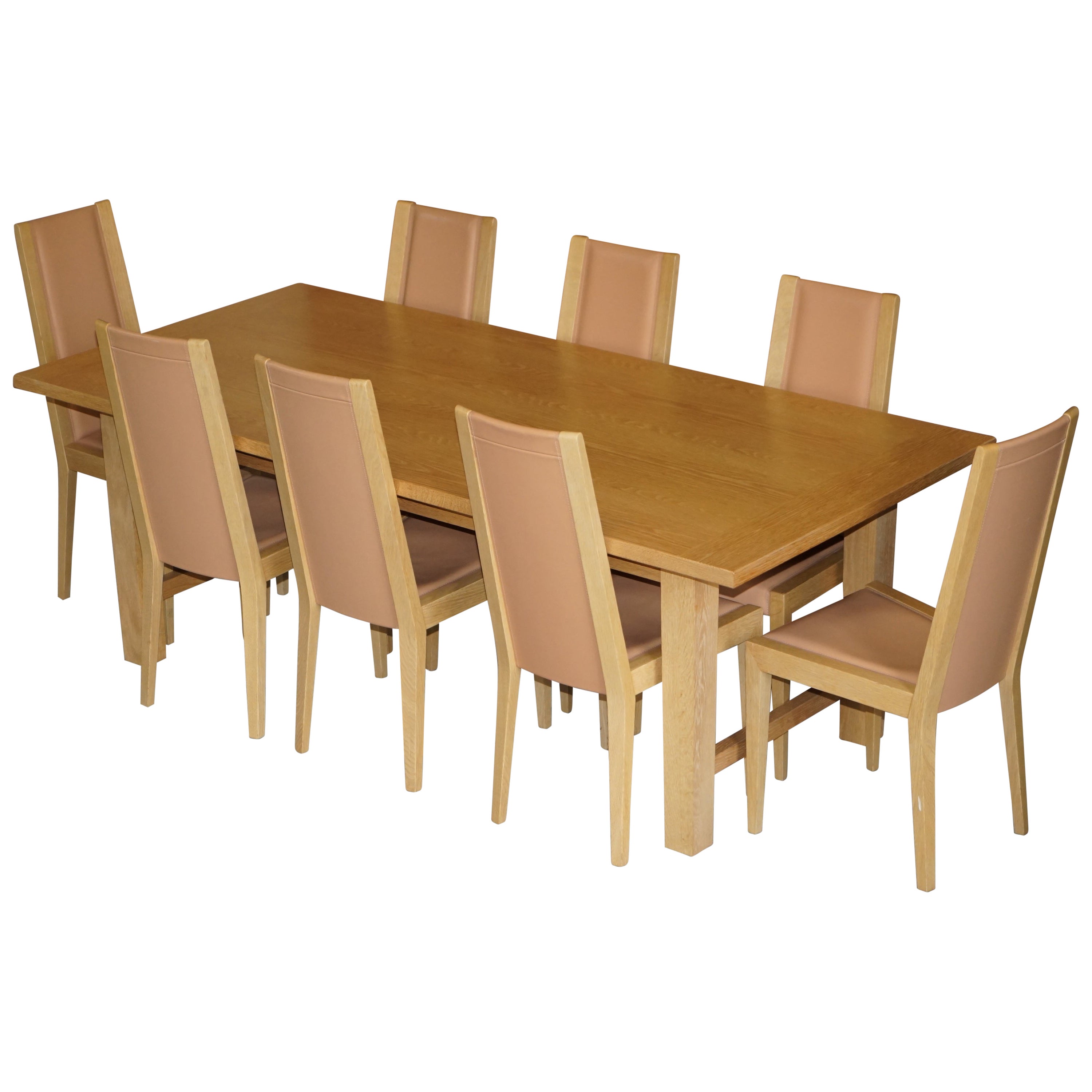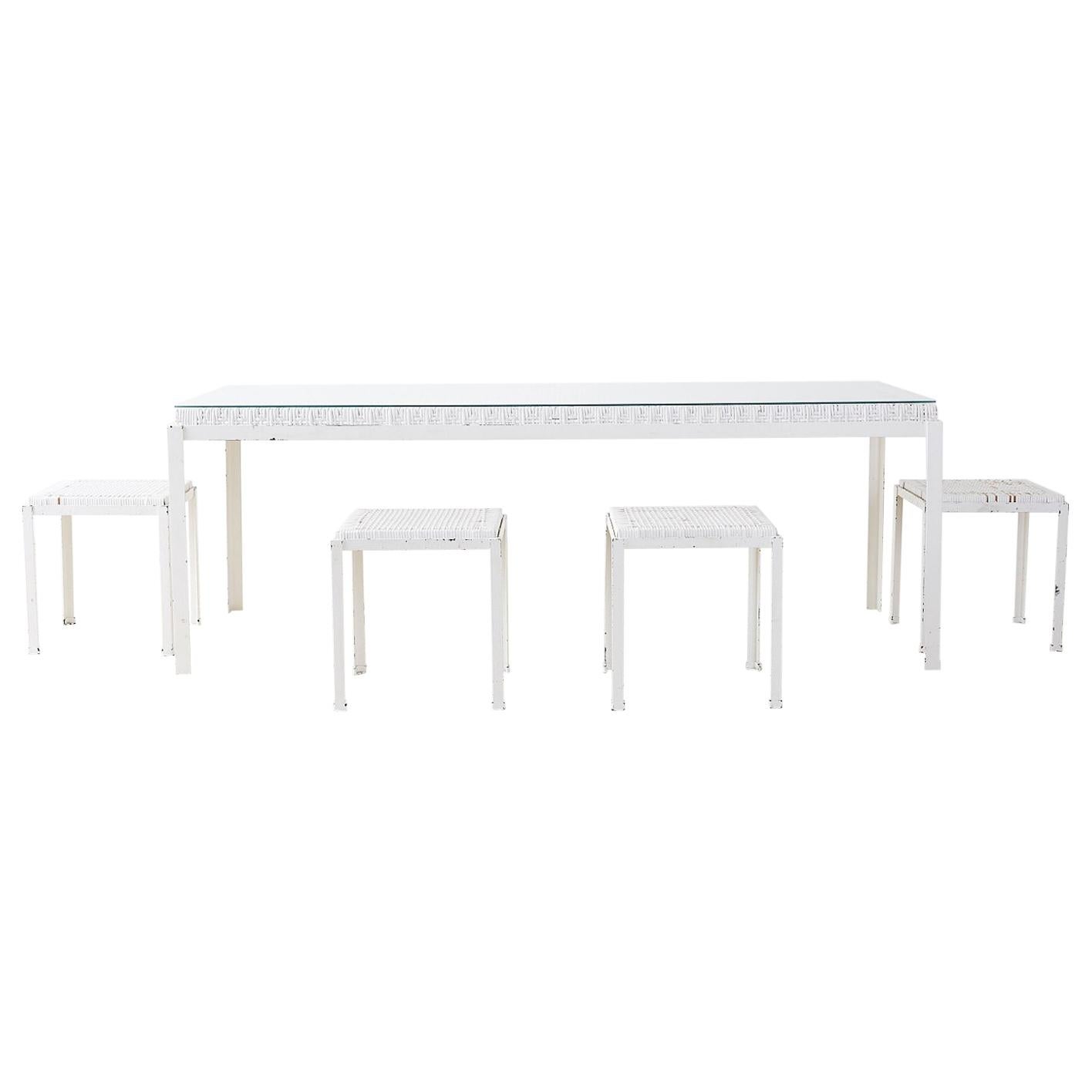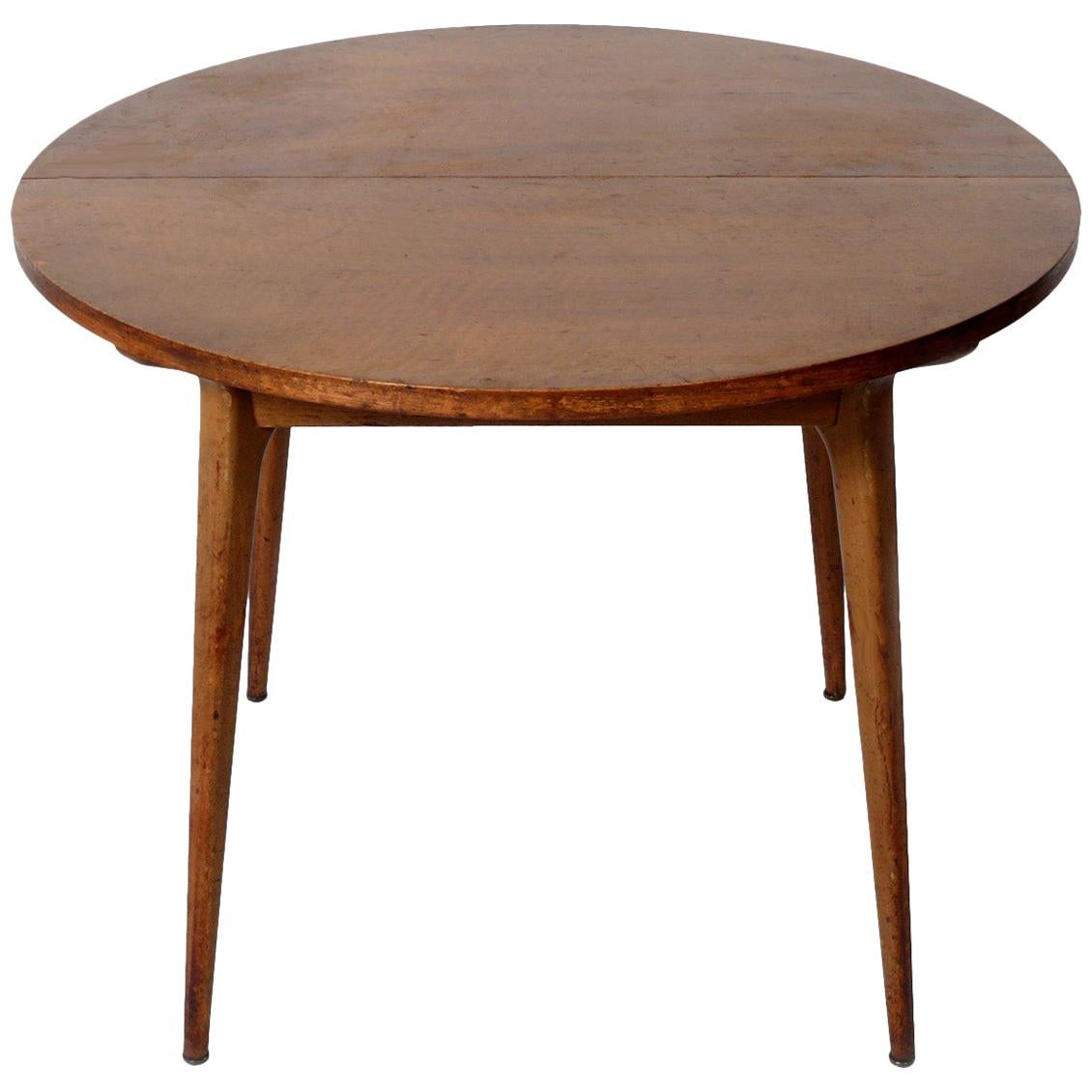Items Similar to Vintage Giancarlo Vegni for Fasem Italy Leather Woven Net Dining Chairs & Table
Want more images or videos?
Request additional images or videos from the seller
1 of 21
Vintage Giancarlo Vegni for Fasem Italy Leather Woven Net Dining Chairs & Table
About the Item
We are delighted to offer for sale this exceptionally rare original vintage Giancarlo Vegni designed for Fasem Italy dining table and Net chair suite
A very good looking and well made suite, I have never seen, nor could I find the table listed anywhere, most likely it was a custom made to order piece
The table base and chairs are all hand woven using thick stitched leather straps, the frames are solid polished chrome, the table top unscrews for ease of transport and has again a thick chrome mount
Condition wise is exquisite, these have obviously been highly coveted
Table dimensions
Height:- 74.5cm
Width:- 129.5cm
Depth:- 129.5cm
Chairs dimensions
Height:- 85cm
Width:- 61cm
Depth:- 55cm
Seat height:- 47.5cm
Please note all measurements are taken at the widest point
This item is available for collection from our Pulborough warehouses
Condition
Please view the very detailed pictures as they form part of the description pertaining to the condition.
Please note vintage period and original items such as leather seating will always have natural patina in the form of creasing and wear, we recommend annual waxing to ensure no moisture is lost, also hand dyed leather is not recommended to sit in direct sunlight for prolonged periods of time as it will dry out and fade.
- Creator:Fasem International (Maker),Giancarlo Vegni (Designer)
- Dimensions:Height: 29.34 in (74.5 cm)Diameter: 50.99 in (129.5 cm)Seat Height: 18.71 in (47.5 cm)
- Sold As:Set of 5
- Style:Mid-Century Modern (In the Style Of)
- Materials and Techniques:
- Place of Origin:
- Period:
- Date of Manufacture:20th Century
- Condition:Wear consistent with age and use. Minor fading.
- Seller Location:GB
- Reference Number:1stDibs: LU2823328434012
About the Seller
4.6
Platinum Seller
These expertly vetted sellers are 1stDibs' most experienced sellers and are rated highest by our customers.
Established in 2012
1stDibs seller since 2017
1,711 sales on 1stDibs
Typical response time: <1 hour
- ShippingRetrieving quote...Ships From: United Kingdom
- Return PolicyA return for this item may be initiated within 14 days of delivery.
More From This SellerView All
- Habitat English Oak Dining Table & 8 Potocco Leather Dining ChairsBy Habitant ShopLocated in GBWe are delighted to offer for sale this very well made, solid English Oak Habitat refectory dining table and eight Potocco leather and oak dining chairs This is a lovely, lightly used suite...Category
20th Century English Mid-Century Modern Dining Room Sets
MaterialsLeather, Oak
- Vintage Art Deco Burr Walnut Ornately Carved Dining Table and 6 Dining ChairsLocated in GBWe are delighted to offer for sale this exquisite heavily carved Art Deco Burr Walnut dining table with six sculptural dining chairs A beautiful example of this kind of work, the ...Category
Early 20th Century English Art Deco Dining Room Tables
MaterialsWalnut
- Stewart Linford Burr Yew & Elm Dining Table & 8 Windsor Chairs Handmade, EnglandLocated in GBWe are delighted to offer for sale this sublime Stewart Linford handmade in England Burr Yew & Elm extending dining table and eight Windsor chairs RRP ...Category
20th Century English Victorian Dining Room Sets
MaterialsElm, Yew
- Limed Oak & Pewter Inlaid David Gregson Arts & Crafts Dining Table & 8 ChairsBy Gregson Manufacturing CompanyLocated in GBWe are delighted to offer this exquisite, hand made in England by David Gregson, stamped and dated, Limed Oak with pewter inlay Arts & Crafts dining table and eight chairs A good looking and well made suite, if you google David Gregson furniture you will find out plenty of information on the great man, his works are stylish, insightful and timeless, the stretchers on the table are so elegant, as good design should always be, it looks sublime from any angle. The subtle use of inlaid pewter is a very nice detail, there are two large circles in the table top made up of smaller circle, the legs to the chairs have the same feature around the bottom Each chair has had grey velvet seat pads...Category
20th Century English Arts and Crafts Dining Room Sets
MaterialsPewter
- Stunning Walnut Parquetry Inlaid Dining Table and Set of 6 Chairs, Bulbous LegsLocated in GBWe are delighted to offer for sale this quality country farmhouse dining table and suite of six chairs. The table is made of solid hardwood with walnut parquetry inlay and the chairs...Category
20th Century English Country Dining Room Tables
MaterialsHardwood, Walnut
- Four Restored Vintage Brown Leather Marcel Breuer B34 Fasem Dining Armchairs 4By Marcel Breuer, Fasem InternationalLocated in GBWe are delighted to offer for sale this one of a kind suite of four, fully restored, Marcel Breuer, Fasem, B34 armchairs in hand dyed brown leather retailed through Fasem Please note the delivery fee listed is just a guide, it covers within the M25 only for the UK and local Europe only for international, if you would like an accurate quote please send me your postcode and I’ll provide you with the exact price These truly are a very rare suite, it's hard to find one of these chairs from this era let alone four, they have all been restored to include having the leather washed back, they’ve then been hand dyed six times, lightly antiqued, sealed then finally waxed down and polished. They are the only suite in the entire world in this exact colour and look a million dollars. They are also super comfortable hence they have stood the test of time and become a true icon. These have countless credits to their name, they have been exhibition in the metropolitan museum of art, the V&A, they have won awards, anyone who is a fine furniture connoisseur will recognize them straight away Condition wise, they have been restored as mentioned, the idea being to keep all the original patina which shows the age and wear, but giving them a one off colour Dimensions Height:- 86cm Width:- 49cm Depth:- 63.5cm Seat height:- 45.5cm Please note all measurements are taken at the widest point, if you would like any additional or specific measurements please ask Any questions please feel free to ask before you bid This item is available for collection from our Pulborough warehouses RH20 1DF. We can have it delivered nationwide to include Scotland Wales and Ireland. Please contact me via email or my contact information...Category
20th Century European Mid-Century Modern Dining Room Chairs
MaterialsChrome
You May Also Like
- Giancarlo Vegni "Rolling-2b" Oval Table, ItalyBy Giancarlo VegniLocated in Downingtown, PAGiancarlo Vegni "Rolling-2b" Oval Table, Italy, Early 21st century The large dramatic & stylish oval table has a smoked glass top set on steel columns wound with leather with st...Category
21st Century and Contemporary Italian Futurist Dining Room Tables
MaterialsSteel
- Park Avenue table by Vegni DesignBy Giancarlo VegniLocated in Cascina, ITStructure: Solid American walnut. Standard Version: American walnut structure. Luxury Version: American walnut structure with edge of the top in leather. * This item can be cus...Category
21st Century and Contemporary Italian Modern Dining Room Tables
MaterialsLeather, Nutwood
- Danny Ho Fong California Modern Woven Cane Dining TableBy Danny Ho FongLocated in Rio Vista, CAChic California modern woven cane top dining table designed by Danny Ho Fong for Tropi-cal. Rare white finish with an iron frame that holds the w...Category
20th Century American Mid-Century Modern Dining Room Tables
MaterialsIron
- Italian Modern Dining Table by Bertha Schaefer for Singer and SonsBy Bertha Schaefer, M. Singer & SonsLocated in Atlanta, GAItalian modern dining table, designed by Bertha Schaefer for Singer and Sons, Italy, circa 1950s. This table is currently being refinished ...Category
Vintage 1950s Italian Mid-Century Modern Dining Room Tables
MaterialsMetal
- Midcentury Giovanni Offredi Paracarro Dining Table and Chairs for Saporiti, 1973By Giovanni Offredi, SaporitiLocated in Roma, ITUnique "Paracarro" model dining table with a set of four chairs. It was designed by Giovanni Offredi and produced by Saporiti in Italy during 1973. Based on a prototype project, i...Category
Vintage 1970s Italian Mid-Century Modern Dining Room Sets
MaterialsConcrete, Chrome, Steel
- Carlo Scarpa Cognac Leather “Kentucky” Dining Chair for Bernini, 1977, Set of 5By Bernini, Carlo ScarpaLocated in Vicenza, ITSet of 5 mod. 783 “Kentucky” dining chairs, designed by Carlo Scarpa for the Italian manufacturer Bernini in 1977. Structure made from oak and walnut timber. Seats and backrest made from cognac leather. Excellent vintage condition. Carlo Scarpa designed this chair for the “Scuderia” series., the last project he made for Bernini. The architect took inspiration from the “shaker” movement. He designed the chair slightly inclined at the front. This feature allows you to swing backward (until you lean on a wall) and remain in balance. Born in Venice on June 2nd, 1906, Carlo Scarpa began working at a very early age. A year after he had first qualified as an architect in 1926, he began working for the Murano glassmakers Cappellin & Co. in a consultative capacity. From 1927, Carlo Scarpa began to experiment with the Murano glass, and this research not only gave him excellent results here but would also inform his progress for many years to come. Between 1935 and 1937, as he entered his thirties, Carlo Scarpa accepted his first important commission, the renovation of Venice’s Cà Foscari. He adapted the spaces of this stately University building that stands on the Grand Canal banks, creating rooms for the Dean’s offices and a new hall for academic ceremonies; Mario Sironi and Mario De Luigi were charged with doing the restoration work on the frescos. After 1945, Carlo Scarpa found himself constantly busy with new commissions, including various furnishings and designs for the renovation of Venice’s Hotel Bauer and designing a tall building in Padua and a residential area in Feltre, all worth mentioning. One of his key works, despite its relatively modest diminished proportions, was the [bookshop known as the] Padiglione del Libro, which stands in Venice’s Giardini di Castello and clearly shows Scarpa’s passion for the works of Frank Lloyd Wright. In the years which were to follow, after he had met the American architect, Scarpa repeated similar experiments on other occasions, as can be seen, in particular, in the sketches he drew up in 1953 for villa Zoppas in Conegliano, which show some of his most promising work. However, this work unfortunately never came to fruition. Carlo Scarpa later created three museum layouts to prove pivotal in terms of how twentieth-century museums were set up from then on. Between 1955 and 1957, he completed extension work on Treviso’s Gipsoteca Canoviana [the museum that houses Canova’s sculptures] in Possagno, taking a similar experimental approach to the one he used for the Venezuelan Pavilion at [Venice’s] Giardini di Castello which he was building at the same time (1954-56). In Possagno Carlo Scarpa was to create one of his most significant ever works, which inevitably bears comparison with two other museum layouts that he was working on over the same period, those of: – Galleria Nazionale di Sicilia, housed in the Palazzo Abatellis in Palermo (1953-55) – Castelvecchio in Verona (1957- 1974), all of which were highly acclaimed, adding to his growing fame. Two other buildings, which are beautifully arranged in spatial terms, can be added to this long list of key works that were started and, in some cases, even completed during the nineteen fifties. After winning the Olivetti award for architecture in 1956, Scarpa began work in Venice’s Piazza San Marco on an area destined to house products made by the Industrial manufacturers Ivrea. Over the same period (1959-1963), he also worked on the renovation and restoration of the gardens and ground floor of the Fondazione Querini Stampalia in Venice, which many consider one of his greatest works. While he busied himself working on-site at the Fondazione Querini Stampalia, Carlo Scarpa also began work building a villa in Udine for the Veritti family. To shed some light on the extent to which his work evolved over the years, it may perhaps be useful to compare this work with that of his very last building, villa Ottolenghi Bardolino, which was near to completion at the time of his sudden death in 1978. Upon completion of villa Veritti over the next ten years, without ever letting up on his work on renovation and layouts, Scarpa accepted some highly challenging commissions, working on the Carlo Felice Theatre in Genoa and another theatre in Vicenza. Towards the end of this decade, in 1969, Rina Brion commissioned Carlo Scarpa to build the Brion Mausoleum in San Vito d’Altivole (Treviso), a piece he continued to work on right up until the moment of his death. Nevertheless, even though he was totally absorbed by work on this mausoleum, there are plenty of other episodes which can offer some insight into the final years of his career. As work on the San Vito d’Altivole Mausoleum began to lessen from 1973, Carlo Scarpa started building the new headquarters for the Banca Popolare di Verona. He drew up plans that were surprisingly different from the work he was carrying out at the same time on the villa Ottolenghi. However, the plans Carlo Scarpa drew up, at different times, for a monument in Brescia’s Piazza della Loggia commemorating victims of the terrorist attack on May 28th, 1974, make a sharp contrast to the work he carried out in Verona, almost as if there is a certain hesitation after so many mannered excesses. The same Pietas that informs his designs for the Piazza Della Loggia can also be seen in the presence of the water that flows through the Brion Mausoleum, almost as if to give a concrete manifestation of pity in this twentieth-century work of art. Carlo Scarpa has put together a highly sophisticated collection of structures, occupying the mausoleum’s L-shaped space stretching across both sides of the old San Vito d’Altivole cemetery. A myriad of different forms and an equally large number of different pieces, all of which are separate and yet inextricably linked to form a chain that seems to offer no promise of continuity, rising up out of these are those whose only justification for being there is to bear the warning “si vis vitam, para mortem,” [if you wish to experience life prepare for death] as if to tell a tale that suggests the circle of time, joining together the commemoration of the dead with a celebration of life. At the entrance of the Brion Mausoleum stand the “propylaea” followed by a cloister which ends by a small chapel, with an arcosolium bearing the family sarcophagi, the main pavilion, held in place on broken cast iron supports, stands over a mirror-shaped stretch of water and occupies one end of the family’s burial space. The musical sound of the walkways teamed with the luminosity of these harmoniously blended spaces shows how, in keeping with his strong sense of vision, Carlo Scarpa could make the most of all of his many skills to come up with this truly magnificent space. As well as a great commitment to architectural work, with the many projects which we have already seen punctuating his career, Carlo Scarpa also made many equally important forays into the world of applied arts. Between 1926 and 1931, he worked for the Murano glassmakers Cappellin, later taking what he had learned with him when he went to work for the glassmakers Venini from 1933 until the 1950s. The story of how he came to work on furniture design is different, however, and began with the furniture he designed to replace lost furnishings during his renovation of Cà Foscari. The later mass-produced furniture started differently, given that many pieces were originally one-off designs “made to measure.” Industrial manufacturing using these designs as prototypes came into being thanks to the continuity afforded him by Dino Gavina, who, as well as this, also invited Carlo Scarpa to become president of the company Gavina SpA, later to become SIMON, a company Gavina founded eight years on, in partnership with Maria Simoncini (whose own name accounts for the choice of company name). Carlo Scarpa and Gavina forged a strong bond in 1968 as they began to put various models of his into production for Simon, such as the “Doge” table, which also formed the basis for the “Sarpi” and “Florian” tables. In the early seventies, other tables that followed included “Valmarana,” “Quatour,” and “Orseolo.” While in 1974, they added couch and armchair “Cornaro” to the collection and the “Toledo” bed...Category
Vintage 1970s Italian Mid-Century Modern Dining Room Tables
MaterialsWalnut, Leather, Plastic
Recently Viewed
View AllMore Ways To Browse
Vintage Leather Table
Glass Top Dining Sets
Mid Century Glass Table Set
Modern Dining Table Leather
Italian Leather Table
Glass Top Dining Room Set
Woven Leather Italian
Italian Dining Table Modern Set
Patina Dining Table Italy
Leather Dining Table Leather Top
Leather Top Dining Table
Craft Tables For Sale
Leather Dining Table Base
Dining Table Set Italy Mid Century
Custom Leather Table
Natural Dining Table Vintage
Dining Chair Sets And Glass Table
Chrome Dining Table Set





